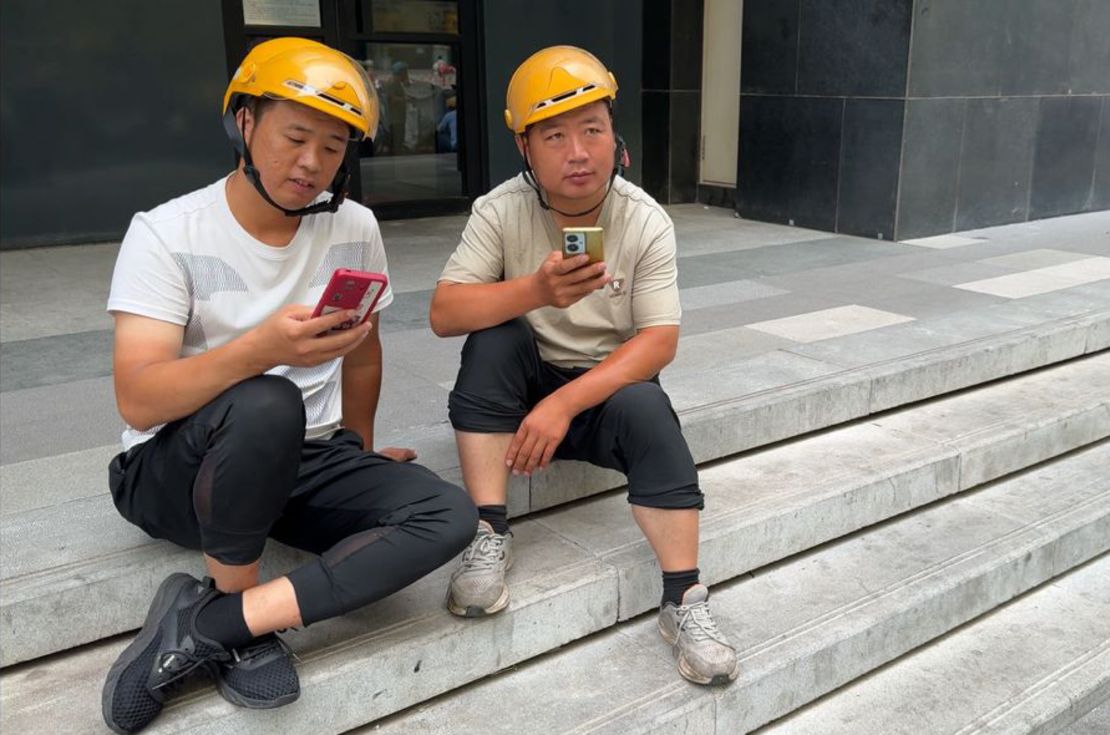A takeout delivery rider suddenly loses it in the middle of the road, smashing his cellphone on the pavement after getting a negative review from a customer.
Another delivery worker gets on his knees to apologize to a cop who pulled him over for running a red light, before jumping up, forcefully pushing over his motorbike and sprinting across a road without regard to traffic.
In yet another incident, crowds of angry drivers gather outside an apartment complex, demanding justice for a fellow delivery driver said to be bullied by security guards there.
They’re among the many episodes of explosive confrontations across China involving delivery workers widely circulated on Chinese social media, showing people stretched to the breaking point.
The $200 billion industry, the world’s largest by revenue and volume of orders, more than doubled during three years of Covid-19 lockdowns and once provided a solid income for casual workers. But not anymore.
As China’s economy grapples with a raft of setbacks, from a protracted property crisis to a lack of consumer spending, delivery workers are taking a beating.
“They are working long hours, really being squeezed,” said Jenny Chan, associate sociology professor at Polytechnic University of Hong Kong. “[And] they will continue to face pressure as [delivery platforms] have to keep the cost low,” she said.
A sluggish economy means people are ordering cheaper meals. That cuts into workers’ earnings because most work on commission, which forces them to work longer hours to maintain their earnings, Chan says.
In addition, the dominance of two major food delivery platforms enables them to dictate contractual terms, leaving little room for workers to push back on deteriorating work conditions, labor rights watchers say.
About 12 million drivers form the backbone of China’s vast food delivery network, which began gaining traction with the 2009 founding of the app Ele.me, now owned by tech giant Alibaba (BABA).
The workers played a critical role in keeping communities afloat during Covid when residents were barred from leaving their homes under strict lockdown rules. Now, they’ve become an indispensable part of the country’s dining culture.
They are omnipresent: crisscrossing a massive network of busy roads and obscure back alleys to deliver meals every day. Some don’t even stop at heavy downpours or gusty typhoons.
The market reached $214 billion in 2023, 2.3 times that of 2020, according to estimates by iiMedia Research, a China-based firm that tracks consumer trends. The industry is projected to reach $280 billion in 2030. Morningstar says China has the biggest takeout delivery market in the world.
These days, workers are constantly under immense pressure to meet tight deadlines, even if it means cutting corners on the road – by speeding or running red lights – causing hazards that endanger both themselves and other road users.
The rider who smashed his phone insisted in an interview with Chinese state media that the complaint lodged against him was groundless. But he says he was still penalized with reduced assignments, which ate into his income and echoed similar complaints.
“What on earth do they want? Do they want me dead?” he said in the video.
Last year, profits at two of the industry’s two biggest players Meituan and Ele.me both surged. Meituan’s revenue stood at $10 billion dollars, up 26% compared to 2022.
Alibaba reported revenues of $8.3 billion for its local services division, driven primarily by Ele.me, in the financial year that ended in March 31, a 19% increase from the previous year.
CNN reached out to both Meituan and Ele.me for comment, but they did not respond.
Against this backdrop, delivery workers’ paychecks have shrunk. In 2018, they made an average of more than $1,000 a month, compared to less than $950 dollars a month in 2023, according to the China New Employment Research Center.
The issue is that despite earning less, many now put in longer hours. Lu Sihang, 20, told CNN that he works a 10-hour shift making 30 deliveries per day. He earns about $30 to $40 each shift. At that rate, Lu has to work almost every day to meet the $950 average.
China’s “downgraded consumption” is to blame, says Gary Ng, an economist with French investment bank Natixis. As China’ economy slows, consumers are spending less.
The economist said even though food is a necessity, a weak economy causes customers to spend less on delivery orders, while restaurants will have to slash prices to attract patrons.
That eats into delivery workers’ income as their pay is usually tied to a commission based on the price of the order. When customers are feeling cash-strapped, they are also less likely to offer tips.
Meanwhile, the lackluster economy means there are fewer jobs, making competition fiercer. China’s youth unemployment rate soared to 18.8% in August, the highest since authorities changed the methodology last year to exclude students.
“If you have a huge supply of workers, their bargaining power will decrease. Meanwhile, there is only a limited amount of delivery orders to share among them,” Ng said.
It wasn’t always this way. Research by China Labour Bulletin, a Hong Kong-based NGO, said the delivery apps initially dug deep into their pockets to offer higher wages in order to attract enough workers for their expansion.
“But as conditions have changed, with platform companies monopolizing the market and algorithm development controlling the labor process, workers have little labor protections and have lost a degree of freedom,” it said.
Many restaurants do not charge a delivery fee. Some even offer cheaper deals than dining in or self-pickups.
Chan, of Polytechnic University, said platforms invested heavily at the outset to slash prices to price out competitors. But now that they have achieved their dominance, they’ve begun to shift the cost burden to drivers by cutting their bonuses and pay.
Earlier this year, state-run online news portal Workers.cn reported several complaints from drivers who said they had done nothing wrong.

A driver said he was fined 86 yuan ($12) for not picking up a prepared order, even though he had informed the restaurant he wouldn’t be taking it because the restaurant had failed to get the food ready on time, Workers.cn reported.
Chan said another problem is that delivery workers are treated as freelancers paid by each trip, rather than getting a monthly salary, which incentivizes them to ignore dangerous road conditions to make as many deliveries as they can.
“Who would want to run a red light if they can deliver the meals safely? But they can’t afford to,” she said.
The consequences have proven fatal. In 2019, a delivery driver died after he was hit by a tree knocked over by strong winds in Beijing, according to state media Global Times.
Just last week (Oct 9), Chongqing Broadcasting Group aired news footage of a deliver driver slamming his scooter into a car at a cross junction in the southern Chinese province of Hunan after running a red light.

A 35-year-old delivery driver who gives only his family name Yang acknowledged the downsides, saying the industry was “not as good as before.”
But he still thinks the job suits him for now, having juggled a slew of previous roles in the past, from selling snacks to working in an office.
“It’s a job with flexibility. If you want to earn more money you will need work longer, if you want to rest, then you can work less,” said Yang.
Read the full article here











Leave a Reply